
Railway Air Services - Glasgow
Glasgow was serviced by Renfrew airport which was 5 miles west of Glasgow near Paisley. It was originally called Moorpark and
was established in 1915 for the testing of airplanes built by Beardmore and W&J Weir. It was the home of Beardmore flying school
from 1915 to 1918 and a compulsory stop in September 1920 in the King’s Cup air race. The auxiliary air squadron no 602 used it
from September 1925 to January 1933 when it was operated by the Scottish Flying Club under a five-year lease (although the club
had used it for several years previously). It is unclear when the name was changed from Moorpark to Renfrew. It appears to have
been interchangeable until 1933. In the 1920 King’s cup it was advertised as Renfrew Airport, but when on the 17th and 18th
September 1932 Alan Cobham’s National Aviation Day tour displayed here the venue was listed as ‘Moorpark Aerodrome’. When
the Scottish Flying Club were granted a five-year lease with Renfrew Town Council they took over and improved the site and
upgraded the facilities to become an airport to be known as Renfrew Aerodrome. The airport was used by RAS from 20th August
1934. It was closed on 1 May 1966 and the main runway was incorporated in the M8 motorway.
Glasgow to London was the only new route of the three routes that started as RAS on the 20th August. The journey to London
started well with no problems in reaching Belfast. At Belfast where two planes ran (the main plane going straight to Manchester
and link service going to Manchester via the Isle of Man) the journey was more difficult and the rest of the route was abandoned
in Manchester. Mail sent on the 20th was only fully flown to Belfast and Manchester. Mail to the Isle of Man was overflown to
Manchester and returned surface via Liverpool. See RAS Update: The Manx Connection. The rest was forwarded by train. A full
service ran on the 21st.
Flown 20th - Belfast, Manchester.
Part flown - Isle of Man (Field says flown, but it was overflown to Manchester), Cardiff, Teignmouth, Plymouth,
Southampton, Cowes, Liverpool. Birmingham, London and Bristol.
Flown 21st - Douglas, Birmingham, Cardiff, Plymouth, Bristol, Southampton, Cowes, London and Bristol. (21st postmarks)
Surface 20th - Liverpool
Timetable Changes
01 October 1934. Liverpool replaces Birmingham and Manchester, so the route now went Glasgow-Belfast-Liverpool-London. 15 April 1935 Manchester and Birmingham were back in the route it now went Glasgow-Belfast-Liverpool-Manchester - Birmingham - London. 25 May 1936, Manchester was again taken out of the route and Stoke-on-Trent put in its place as a request stop. Birmingham was also a request stop. 10 May 1937 the Isle of Man was once more included on the route but only on the afternoon flight. 2 May 1938 because of the Empire exhibition in Glasgow a direct route was offered after Liverpool missing out Glasgow. 22 May 1939 Stoke on Trent was removed from the schedules as a request stop.RAS Railway Air Services Covers flown from Glasgow 20th August 1934

To assist visitors to the Empire Exhibition at Glasgow,
Railway Air Services commenced a direct service between
Glasgow and Liverpool on the 2nd May 1938 obviating the
detour to Ireland. The service ceased on the 3rd September
that year.
Approximately twenty covers were carried from Glasgow to
London on the first day which bear the Exhibition Red and
White’ sticker with the inscription ‘First Direct Glasgow -
London Air Mail.
Copyright
© 2022 Robert Farquharson All Rights Reserved
Empire Exhibition Glasgow 2nd May 1938


Cover flown on 20th Glasgow to Belfast
Cover flown 20th Glasgow to Belfast 20th backstamp

The following example shows what happened with the Glasgow to Isle of Man mail. Accidentally the mail was overflown to Manchester and returned
to the Isle of Man by boat. As can be seen below despite being flown the mail did not arrive till the 21st.

January 25th 1936. After the reintroduction of the RAS
contract, the railway letter stopped. For some reason
Glasgow kept the 3d paid cachet. However, the railway
letter was an air letter and would have had the postmark of
the destination.


5th Feb 1936. Last recorded date for a railway letter.
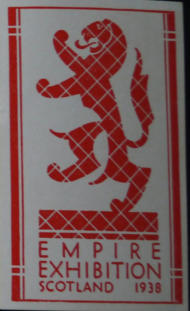

Exhibition Envelope
Mint Label

British Internal Airmails of the 1930’s


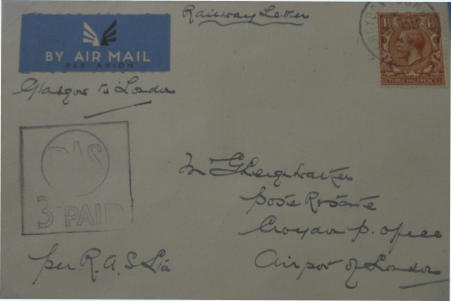




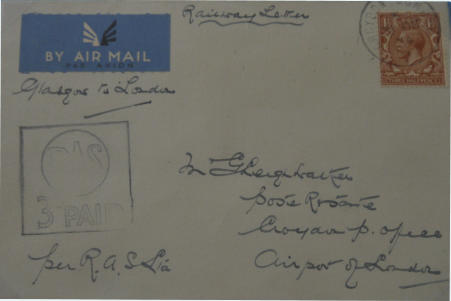













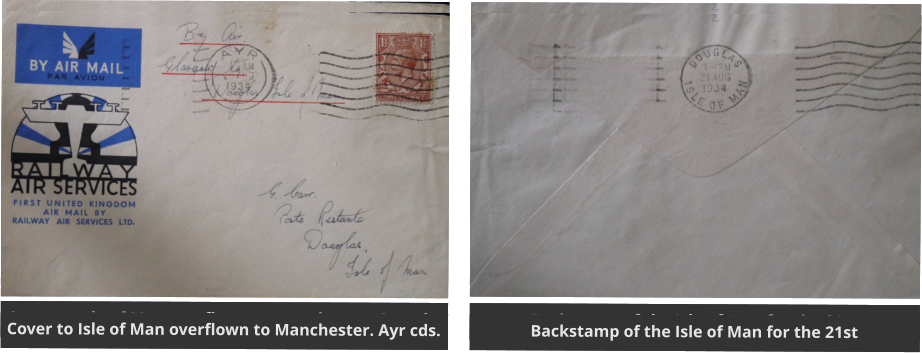

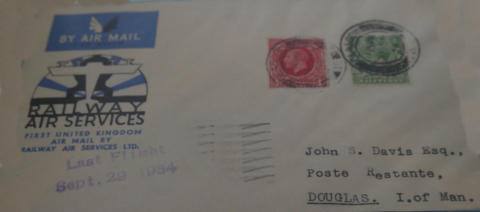
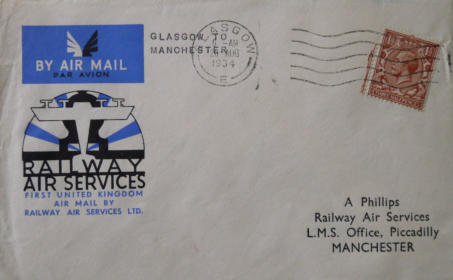
Cover flown on 20th Glasgow to Manchester
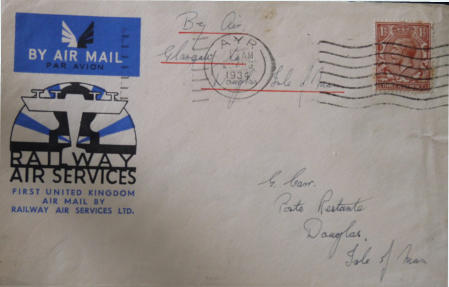
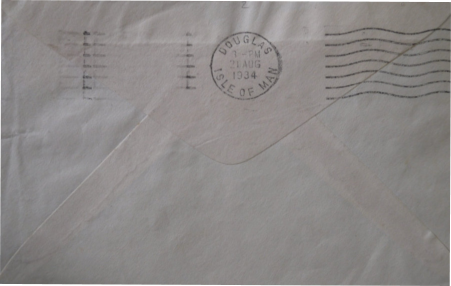






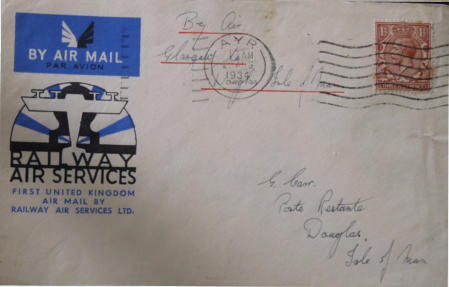








Railway Air Services - Glasgow
Glasgow was serviced by Renfrew airport which was 5 miles west of Glasgow near Paisley. It was originally called Moorpark and
was established in 1915 for the testing of airplanes built by Beardmore and W&J Weir. It was the home of Beardmore flying school
from 1915 to 1918 and a compulsory stop in September 1920 in the King’s Cup air race. The auxiliary air squadron no 602 used it
from September 1925 to January 1933 when it was operated by the Scottish Flying Club under a five-year lease (although the club
had used it for several years previously). It is unclear when the name was changed from Moorpark to Renfrew. It appears to have
been interchangeable until 1933. In the 1920 King’s cup it was advertised as Renfrew Airport, but when on the 17th and 18th
September 1932 Alan Cobham’s National Aviation Day tour displayed here the venue was listed as ‘Moorpark Aerodrome’. When
the Scottish Flying Club were granted a five-year lease with Renfrew Town Council they took over and improved the site and
upgraded the facilities to become an airport to be known as Renfrew Aerodrome. The airport was used by RAS from 20th August
1934. It was closed on 1 May 1966 and the main runway was incorporated in the M8 motorway.
Glasgow to London was the only new route of the three routes that started as RAS on the 20th August. The journey to London
started well with no problems in reaching Belfast. At Belfast where two planes ran (the main plane going straight to Manchester
and link service going to Manchester via the Isle of Man) the journey was more difficult and the rest of the route was abandoned
in Manchester. Mail sent on the 20th was only fully flown to Belfast and Manchester. Mail to the Isle of Man was overflown to
Manchester and returned surface via Liverpool. See RAS Update: The Manx Connection. The rest was forwarded by train. A full
service ran on the 21st.
Flown 20th - Belfast, Manchester.
Part flown - Isle of Man (Field says flown, but it was overflown to Manchester), Cardiff, Teignmouth, Plymouth,
Southampton, Cowes, Liverpool. Birmingham, London and Bristol.
Flown 21st - Douglas, Birmingham, Cardiff, Plymouth, Bristol, Southampton, Cowes, London and Bristol. (21st postmarks)
Surface 20th - Liverpool
Timetable Changes
01 October 1934. Liverpool replaces Birmingham and Manchester, so the route now went Glasgow-Belfast-Liverpool-London. 15 April 1935 Manchester and Birmingham were back in the route it now went Glasgow-Belfast-Liverpool-Manchester - Birmingham - London. 25 May 1936, Manchester was again taken out of the route and Stoke-on-Trent put in its place as a request stop. Birmingham was also a request stop. 10 May 1937 the Isle of Man was once more included on the route but only on the afternoon flight. 2 May 1938 because of the Empire exhibition in Glasgow a direct route was offered after Liverpool missing out Glasgow. 22 May 1939 Stoke on Trent was removed from the schedules as a request stop.RAS Railway Air Services Covers flown from Glasgow 20th August 1934

Copyright
© 2020 Robert Farquharson All Rights Reserved
Empire Exhibition Glasgow 2nd May 1938

Cover flown on 20th Glasgow to Belfast

The following example shows what happened with the Glasgow to Isle of Man mail. Accidentally the mail was overflown to Manchester and returned
to the Isle of Man by boat. As can be seen below despite being flown the mail did not arrive till the 21st.



Exhibition Envelope

British Internal Airmails of the 1930’s










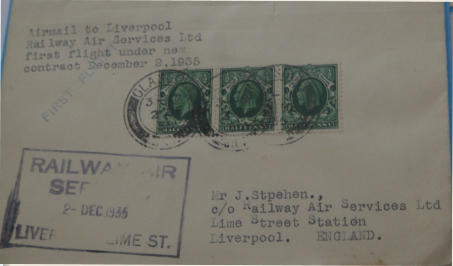






Cover flown on 20th Glasgow to Manchester






























































































